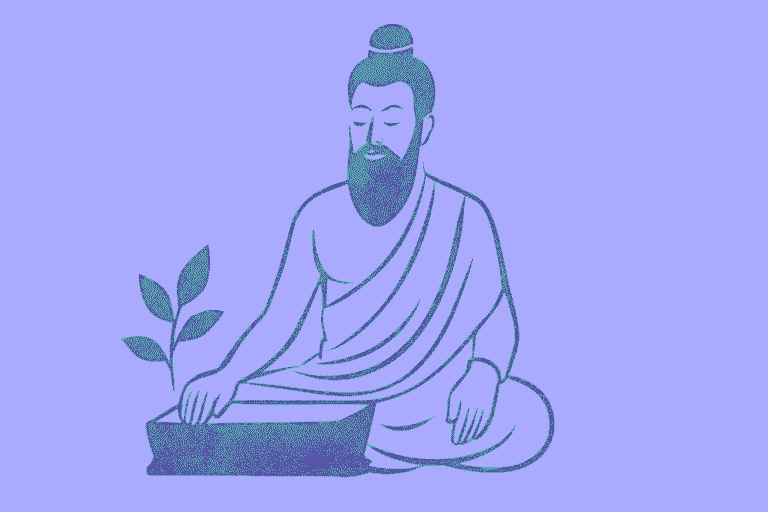contact@cayeit.com
Ayurveda considers that health and wellness depend on a delicate balance between the mind, body, and spirit. According to Ayurveda, the mind and body are interconnected, and a healthy mind leads to a healthy body, and vice versa. In this blog, we will explore the ways in which Ayurveda can be used to improve mental health. Sattva, Rajas, and Tamas are three basic qualities that are considered to govern the mind and body. We will also explore the ways in which Sattva, Rajas, and Tamas can impact mental health.
Sattva is the quality of balance, harmony, and purity. It is associated with peace, happiness, and contentment. A person with a predominance of Sattva is said to be calm, clear-headed, and at ease. It is said to have a positive impact on mental health, promoting feelings of well-being, clarity, and inner peace.
Rajas is the quality of movement and action. It is associated with energy, passion, and ambition. A person with a predominance of Rajas is said to be active, outgoing, and driven. They may be prone to feelings of restlessness, anxiety, and agitation. While Rajas can be positive in balance state, an excess of it can lead to mental health issues such as anxiety, insomnia, and irritability.
Tamas is the quality of inertia and darkness. It is associated with dullness, ignorance, and apathy. A person with a predominance of Tamas is said to be lazy, slow, and dull. They may be prone to feelings of depression, apathy and lack of motivation. Tamas can lead to a lack of energy and focus, which can lead to negative mental health states.
To promote Sattva and improve mental health, Ayurveda recommends a combination of diet, lifestyle changes, and meditation.
Diet to regulate Sattva, Raja and Tama:
In Ayurveda, the properties and qualities of food are believed to have a direct impact on the mind and body. According to Ayurveda, food can be classified into three categories: Sattvika, Rajasika, and Tamasika. The properties and impact of each type of food on the mind and the way these can promote mental well-being, is mentioned here under.
Sattvika food is considered to be pure and nourishing. It is made from whole, natural ingredients and is easy to digest.Sattvika food is believed to promote feelings of peace, happiness, and contentment. Examples of Sattvika food include fresh fruits, vegetables, whole grains, and legumes.
Rajasika food is considered to be stimulating and energizing. It is made from spicy, pungent, and sour ingredients and can be difficult to digest. Rajasika food is believed to promote feelings of restlessness, anxiety, and agitation. Examples ofRajasika food include spicy foods, fried foods, and processed foods.
Tamasika food is considered to be heavy, dull, and toxic. It is made from spoiled, stale, and processed ingredients and can be difficult to digest. Tamasika food is believed to promote feelings of depression, apathy, and lack of motivation. Examples of Tamasika food include alcohol, tobacco, and drugs.
To promote Sattva and improve mental health, Ayurveda recommends consuming Sattvika food and avoiding Rajasikaand Tamasika food. A diet that is balanced, nutritious and easy to digest can help to bring balance to the mind and body. It is also important to pay attention to how different foods make you feel and make adjustments accordingly.
Ayurveda suggests some specific foods that can be beneficial for mental well-being. For example, Ghee is considered to be a Sattvika food that can help to improve memory and concentration. Milk and Milk products are also considered to be Sattvika and they can help to pacify the mind.
Lifestyle and activities:
Activities that promote Sattva:
- Meditation and Yoga are considered to be Sattvic practices that can help to bring balance to the mind and body. It can help to reduce stress and anxiety, improve mood and self-awareness, and reduce symptoms of depression.
- Pranayama (breathing exercises) and chanting mantras can also help to promote Sattva.
- Reading spiritual texts, listening to soothing music, and spending time in nature are also considered to be Sattvicactivities.
Activities that promote Rajas:
- Competitive sports, excessive exercise, and high-stress work environments can increase Rajas in a person.
- Consuming spicy, pungent, and sour foods, as well as caffeine and alcohol, can also promote Rajas.
- Engaging in excessive entertainment, such as watching too much television or playing video games for long periods, can also increase Rajas.
Activities that promote Tamas:
- Leading a sedentary lifestyle and consuming heavy, processed, and stale foods can increase Tamas in a person.
- Using drugs, alcohol, and tobacco can also promote Tamas.
- Engaging in negative thinking, such as dwelling on past mistakes or worrying about the future, can also increase Tamas.
To promote Sattva and improve mental health, Ayurveda recommends engaging in activities that promote Sattva and avoiding activities that promote Rajas and Tamas. By making a conscious effort to engage in Sattvic activities and to avoid activities that promote imbalance, one can achieve improved mental health.
Sleep:
The balance of Sattva, Rajas, and Tamas is crucial for maintaining health, and sleep can impact this balance.
- Adequate sleep is crucial for physical and mental well-being. It is considered to be a Sattvic activity that promotes balance, harmony, and purity.
- Lack of sleep can increase Rajas, leading to feelings of restlessness, anxiety, and agitation.
- Excessive sleep can increase Tamas, leading to feelings of dullness, apathy, and lack of motivation.
Exercise:
- Regular exercise is considered to be a Sattvic activity that promotes balance, harmony, and purity.
- Moderate exercise can help to reduce stress and anxiety, improve mood, and reduce symptoms of depression.
- Excessive exercise can increase Rajas, leading to feelings of restlessness, anxiety, and agitation.
In conclusion, consuming Sattvika food, engaging in Sattvika lifestyle, regular exercise and getting enough sleep; one can achieve good mental health.





